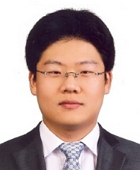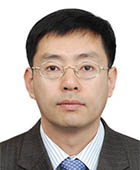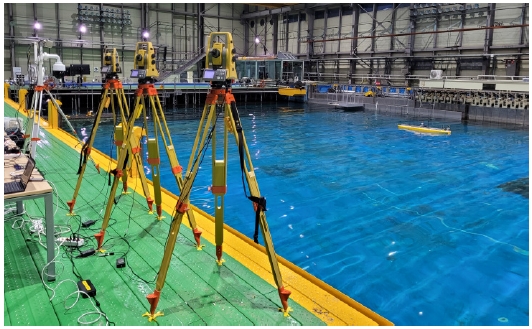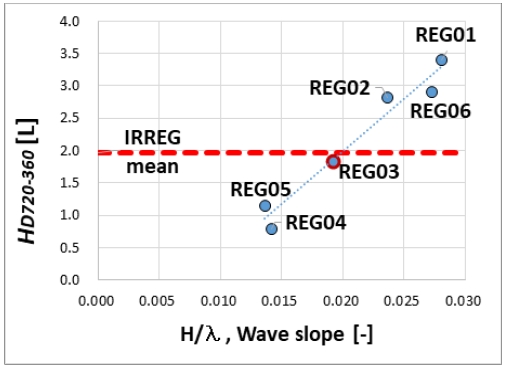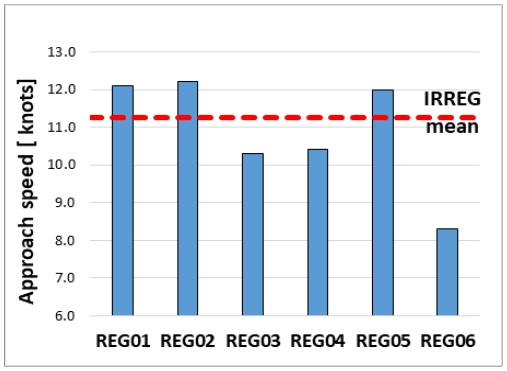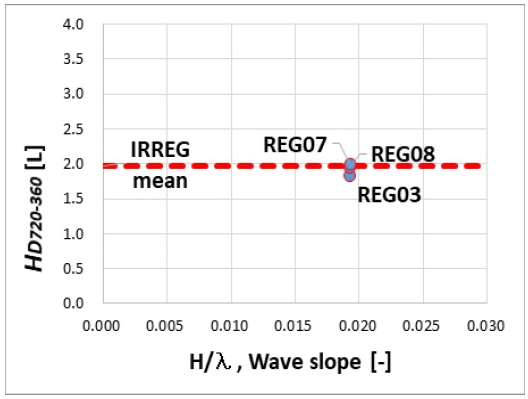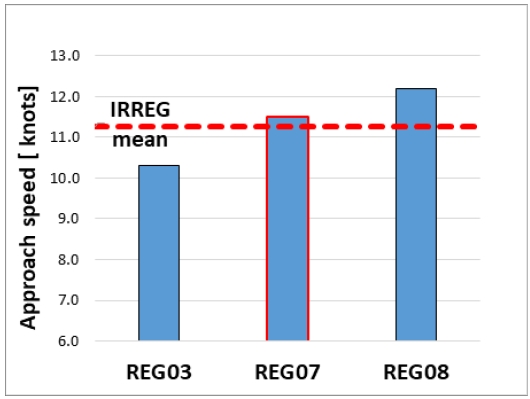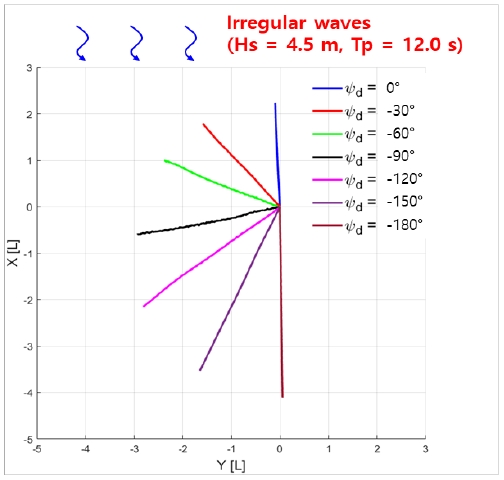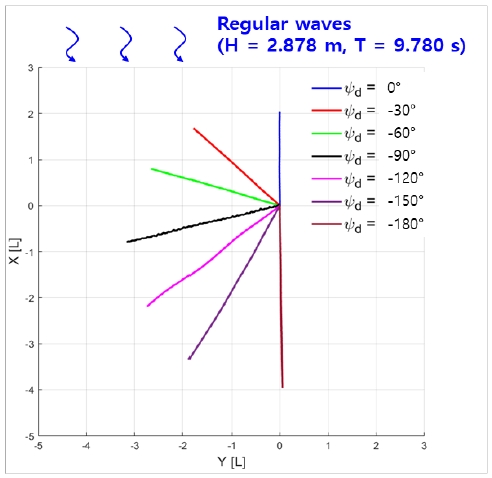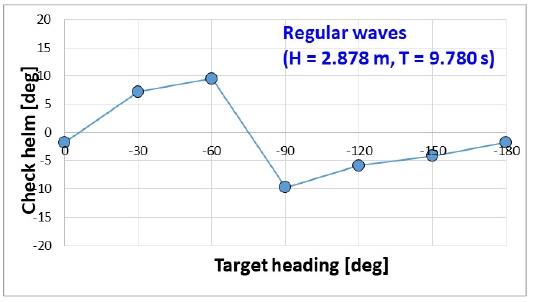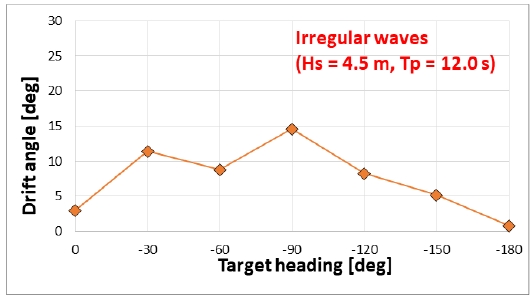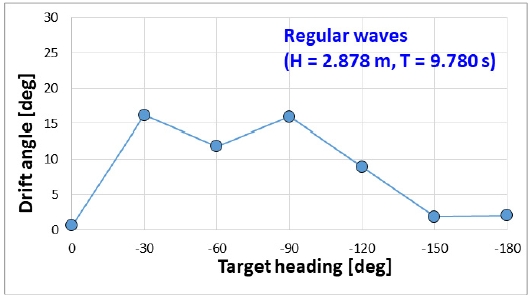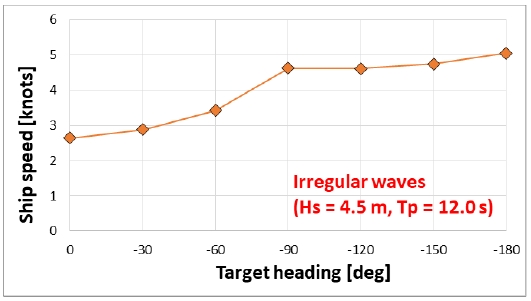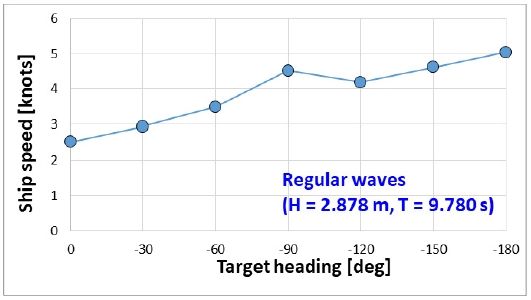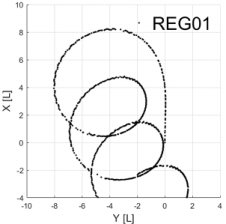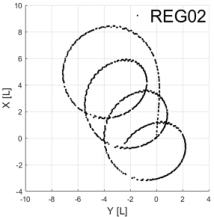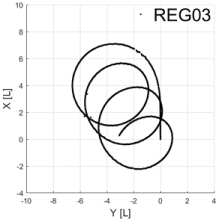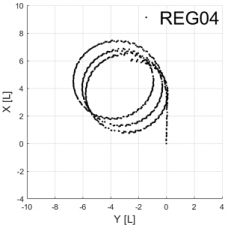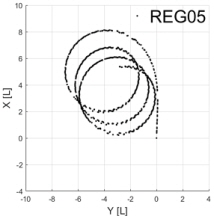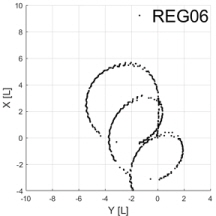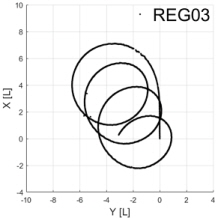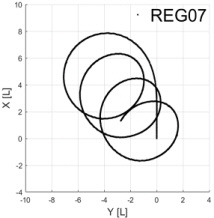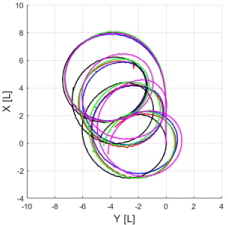
KSUPRAMAX 모형선의 장파정 불규칙파 중 전진속도 및 선회궤적을 유사 재현하는 규칙파 탐색
This is an Open-Access article distributed under the terms of the Creative Commons Attribution Non-Commercial License(http://creativecommons.org/licenses/by-nc/3.0) which permits unrestricted non-commercial use, distribution, and reproduction in any medium, provided the original work is properly cited.
Abstract
It is necessary to predict the ship’s manoeuvrabilities in waves for its safe operations in adverse weather. At the early design stage, free-running model tests can be performed to estimate the ship’s manoeuvring performance in irregular wave conditions. The wave elevations are randomly varied with times in irregular waves, large deviations of the manoeuvring performance indices are likely to occur depending on the start time of steering scenarios. In this study, a KSUPRAMAX model ship’s manoeuvres in long-crested irregular waves are reproduced in the equivalent regular waves. The equivalent regular waves are searched from the energy flux relations between long-crested irregular and regular waves. But there are differences of forward speeds in the model tests, regular wave height and period are modified so that both the forward speed and the trajectory drift in regular waves are similar to those in irregular waves. In addition, low speed course-keeping tests are performed with various wave incident angles in irregular and regular waves. It is confirmed that check helms, drift angles, and speeds as well as trajectories in irregular waves are similar to those in equivalent regular waves.
Keywords:
KSUPRAMAX bulk carrier, Adverse weather condition, Forward speed, Trajectory drift, Check helm키워드:
KSUPRAMAX 벌크선, 황천 조건, 전진 속도, 궤적 밀림, 중립타각1. 서 론
일반적으로 선박 조종성능은 정수 중 성능을 기준으로 하여 평가하여 왔다. 그러나 조종성능은 대상 선박의 하중 조건, 운항 선속, 해상 환경 등에 따라 현저하게 변화한다. 더불어 최근 탄소중립을 위한 IMO 규제 강화로 신조 선박의 엔진 출력 및 운항 선속이 낮아지는 추세이며, 특히 저속 화물선의 황천 중 최소한의 조종성능 확보를 위한 최소추진추력 잠정 지침도 발효된 바 있다 (IMO, 2021). 따라서 최근에는 선박 운항 환경을 복합적으로 고려한 조종성능 평가 기술이 더 빈번하게 요구되고 있다.
파도 중 선박 조종성능의 실험적, 혹은 이론적 접근법에 대해서는 다양한 선행 연구들이 있으며, 이 중에서 본 논문과 직접 관련되는 실험적 연구에 초점을 두어 정리하면 다음과 같다. Hirano et al. (1980) 는 규칙파 중 RoRo 선박의 자유항주 선회 모형시험을 수행하였으며, Hirayama and Kim (1994) 은 탱커선 모형의 장파정 및 단파정 불규칙파 중 지그재그 시험을 실시한 바 있다. Ueno et al. (2003) 은 규칙파 중에서 탱커선형의 표준 조종 모형시험을 수행하고 특히 선회 궤적의 밀림거리 및 각도 정의에 대하여 논하였다. Yasukawa (2006; 2008) 연구에서도 컨테이너선 모형의 자유항주 선회, 지그재그 및 정지시험을 수행하고, 정수 중 조종운동 모델 외력에 파표류력 성분을 추가한 시뮬레이션을 병행하였다. 이후 Yasukawa et al. (2015) 에서 KVLCC2 탱커를 대상으로 불규칙파 중 모형시험 및 시뮬레이션의 후속 연구가 수행된 바 있다. Sanada et al. (2013; 2018) 는 ONR tumblehome 함정에 대한 자유항주 시스템을 구성하고 규칙파 중 직진, 선회, 지그재그 모형시험을 실시하였다. Sprenger et al. (2017), Shigunov et al. (2018) 는 황천 중 선박 조종 및 추진출력 성능에 초점을 둔 EU SHOPERA 프로젝트에서 DTC 컨테이너선, KVLCC2 탱커의 기관 별 벤치마크 모형시험 및 수치계산 결과를 비교, 분석하였다. 그리고 최근 Kim et al. (2019; 2022)에서 KVLCC2 탱커의 규칙파, 불규칙파 중 선회성능, 그리고 Kim et al. (2020)에서 KCS 컨테이너선의 규칙파 중 초기선회성능에 초점을 둔 자유항주시험이 수행되었다. Rabliås and Kristiansen (2022) 는 DTC 컨테이너선의 규칙파 중 자유항주 조종시험 및 수치시뮬레이션을 비교하였다. Suzuki et al. (2020; 2023) 는 파도 중 모형선 조종 및 추진성능의 실선 확장을 시도하고 특히 단파장에서의 침로유지 상황을 모형시험 및 시뮬레이션으로 다룬 바 있다.
본 연구에서는 공개 벌크선형인 KSUPRAMAX 선형을 대상으로 IMO 최소추진출력 잠정지침 내에 정의된 황천 불규칙파 조건을 해양공학수조에서 재현하고, 자유항주 모형시험을 통하여 파도 중 조종성능을 분석하였다. 단, 수조의 제한된 영역 내에서 황천 불규칙파 중의 조종성능을 통계적으로 도출하려면 많은 반복시험이 필요하다. 불규칙파는 매 순간 조우 파도 시계열이 변화하므로 직진 이외의 지그재그 등 조타 시나리오가 있을 경우 조타 시점에 따라 오버슈트각 등 성능 지수들의 편차가 매우 커질 수 있다. 이와 같이 불규칙파 중 조종 상황은 파도와 조타시점의 임의성이 합쳐져서 결과의 편차가 커지며 통계 해석에 어려움이 있다. 따라서 본 연구에서는 불규칙파 중 조종성능을 유사하게 재현할 수 있는 대응 규칙파를 탐색하였다. 먼저 대상선의 설계속도 부근에서 불규칙파 중 선회시험을 반복하였다. 초기 직진속도, 선회궤적 밀림이 해당 불규칙파 중의 전후동요 방향 부가저항과 좌우, 선수동요 방향 파표류력을 대표하는 값으로 판단하여 두 결과를 모두 유사하게 재현할 수 있는 규칙파를 탐색하였다. 그리고 황천 중 실선은 주로 저속에서 운항됨을 고려하여, 불규칙파와 대응 규칙파 중에서 저속 영역의 파향 별 침로유지시험을 수행하였다. 불규칙파 중 침로유지 궤적과 더불어 중립타각, 선체 편류각, 선속의 시간 평균값이 대응 규칙파 중에서 유사하게 재현될 수 있음을 확인하였다.
2. 자유항주 모형시험
대상선은 KSUPRAMAX 벌크선이며, 실선을 1/64 축소한 모형선으로 자유항주시험을 수행하였다. 실선, 모형선 제원 및 자유항주 모형선 사진을 각각 Table 1, Fig. 1에 나타내었다. 설계 실선의 GM은 8.586m 이나 모형선 장비 밸러스팅 과정에서 KG가 초기 설계값 대비 50% 증가하고, 그에 따라 GM은 감소하였다. 모형선 GM 0.080m 을 실선 스케일로 환산하면 5.129m이다.
선박해양플랜트연구소 해양공학수조 (길이 56m × 폭 30m × 깊이 4.5m) 에서 자유항주 모형시험을 수행하였으며, Fig. 2와 같다. 전차를 운용하지 않고 육상에서 모형선 PC에 원격 접속하여 모형선을 제어하며, 자이로, 경사계, 추력 및 조타 제어기, 무선모뎀 등이 선내에 탑재된다. 실내 환경이므로 GPS 대신 모형선 갑판에 고정된 프리즘을 레이저 추적하는 방식으로 모형선 위치를 실시간 추적, 기록하였다. 시스템 구성은 Yun et al. (2015) 및 Kim et al. (2019) 에 소개된 바 있다. 단, 선행 연구에 비하여 모형선 갑판의 위치 추적용 프리즘 타겟을 2개에서 3개로 늘려서 모형선 3차원 변위를 계측할 수 있도록 시스템을 개선하였다.
제 76차 MEPC 회의를 통하여 최소추진출력 잠정 지침 내 정의된 황천 조건은 Table 2와 같다.
Table 2에 따라 황천 불규칙파 조건을 Table 3과 같이 설정하였다. 본 시험에서 바람은 생성하지 않았으며, 평균풍속 19.0 m/s 바람이 추가될 경우 동일 전진속도를 유지하기 위한 모형선 자항점은 본 시험 값보다 다소 높아질 것임을 밝혀둔다.
자유항주 모형시험 조건은 Tables 4~6 과 같다. Table 4와 같이 정수 중 실선 설계속도 14.5 knots 에 대응하는 모형선 자항점 19.0 RPS를 고정하고, 장파정 불규칙파 중에서 35° 좌현선회를 총 5회 반복하였다. 그리고 Table 5처럼 규칙파 조건을 총 8가지로 변경하면서 35° 좌현선회 시험을 하고, 불규칙파 중의 초기 직진속도 및 선회궤적 밀림을 유사하게 재현하는 규칙파를 탐색하였다. 최종 선택된 규칙파와 불규칙파 중 파향 별 저속 직진시험을 수행하였고, Table 6과 같다.
3. 불규칙파에 대응하는 규칙파 탐색
3.1 장파정 불규칙파 중 35° 좌현 선회시험
Table 3 조건의 장파정 선수 불규칙파 중에서 실선 설계속도 14.5 knots 에 대응하는 모형선 자항점 19.0 RPS로 좌현 35° 선회시험을 수행하였다. 해당 불규칙파를 검교정하여 준비한 후, 다양한 구간에서 시험하여 매 시험마다 임의의 파형을 조우하도록 하였다. 통계 분석을 위하여 동일 시험을 총 5회 반복하였다. Fig. 3은 시험에서 얻은 초기 직진속도, 선회궤적 밀림거리 및 각도 결과이다. 밀림거리, 밀림각도 정의는 ITTC (2021a), SIMMAN (2023) 의 기호를 활용하되, Kim et al. (2019, 2022) 을 참고하여 선수각 360°, 720° 인 두 지점을 기준으로 하여 분석하였다.
3.2 규칙파 중 35° 좌현 선회시험 (1)
ITTC (2021b) 2.8절에 의하면 규칙파, 장파정 불규칙파의 단위 폭 당 에너지 플럭스 PW (unit: W/m) 는 식 (1), (2)와 같다.
| (1) |
| (2) |
식 (1)에서 ζa, cG는 각각 규칙파 진폭, 군속도 (group velocity) 이다. 식 (2)에서 HS은 불규칙파 유의파고, TE는 에너지주기이며 파 에너지 스펙트럼 상에서 2π(m-1/m0)로 정의된다. mn은 파 에너지 스펙트럼 하부 면적의 n차 모멘트이다.
식 (1)에 무한수심의 분산관계식 ω2 = gk 및 군속도 cG = (ω/k)/2 를 대입하면, 식 (3)과 같이 전개된다. H, T는 각각 규칙파의 파고, 주기이다.
| (3) |
따라서 식 (2), (3)으로부터 장파정 불규칙파와 파 에너지가 동일한 것으로 추정된 규칙파의 파고, 주기는 Table 7과 같다.
한편 ITTC (2003)의 Appendix A에 의하면 파 에너지 스펙트럼에서 통계적으로 유의미한 주기로 제로교차(zero-crossing), 평균(mean), 에너지(energy), 모달(modal) 주기가 있다. 이를 참고하여 Table 8과 같이 규칙파 파고 , 파주기 TE를 기준으로 주기는 네 가지, 파고는 세 가지로 변경하여 총 6종의 규칙파를 생성하였다. 아래첨자 Z, M, E, P는 각각 제로교차, 평균, 에너지, 모달 주기를 의미한다.
REG01~06 선수 규칙파 중에서 앞 절과 동일한 자항점 19.0 RPS의 35° 좌현 선회시험을 수행하고, 궤적 결과를 Table 9에 나타내었다. 각 규칙파 중에서 궤적 밀림의 주요 지수인 밀림거리와 초기 직진속도를 불규칙파 중 평균값과 비교하면 각각 Figs. 4, 5와 같다.
Tables 7, 8에서 불규칙파와 동일한 에너지 플럭스로 도출되었던 REG03은 Fig. 4에서처럼 밀림거리는 불규칙파 중에서의 결과와 유사하나, Fig. 5처럼 초기 직진속도는 다소 낮다. 식 (1)~(3)은 파도만을 고려한 이론적 수식이며, 실제 선박의 전진속도는 파도 중 선박의 상대 운동, 선수/선미 상대파고 차이에 따른 부가저항이 중요하므로 이와 같은 차이가 발생하는 것으로 추정된다 (Kim and Kim, 2010; Park et al., 2023).
다만 흥미로운 것은 Fig. 4에서처럼 선회궤적 밀림거리는 파 기울기에 대체로 비례하는 경향을 보인다. 이는 Kim et al. (2020)의 타 컨테이너 선형에 대해서도 확인된 바 있다. 궤적 밀림거리를 REG03과 같게 유지하면서 초기 직진속도는 높일 수 있는 규칙파 조건을 다음 절에서 추가 탐색하기로 한다.
3.3 규칙파 중 35° 좌현 선회시험 (2)
선회궤적 밀림거리를 REG03 과 같은 수준으로 유지하기 위하여 파 기울기는 고정하고, 초기 직진속도를 높이기 위하여 파고를 단계적 감소시켜 REG07, 08을 생성하였다. Table 10과 같다.
Table 11에 세 가지 선수 규칙파 중 35° 좌현 선회의 결과를 나타내었다. Figs. 6, 7에서는 선회궤적 밀림거리와 초기 직진속도를 불규칙파 중에서의 결과와 비교하였다. 파고와 파주기가 크게 달라지더라도 파 기울기가 일정하면 Fig. 6에서와 같이 밀림거리는 거의 동일하며, 단 Fig. 7처럼 파고가 감소할수록 초기 직진속도는 증가한다.
불규칙파에서의 직진 부가저항과 조종상태 횡방향 표류력을 모두 유사하게 재현하는 목적으로 초기 직진속도와 선회궤적 밀림 거리가 가장 유사한 REG07을 불규칙파에 대응하는 규칙파로 최종 선정하였다. 앞 절에서 이론적인 기준 규칙파로 삼았던 REG03와 비교하면 파고와 파장이 각각 약 90%이다. 파도 조건 및 궤적, 주요 결과를 한 번 더 정리하여 비교하면 Table 12와 같다.
4. 파향 별 저속 침로유지시험
불규칙파 중 파향 별 저속 침로유지성능이 대응 규칙파 중에서 잘 재현되는가 확인하기 위하여, 목표 선수각을 0°(선수파 조우)부터 –180°(선미파 조우)까지 30° 간격으로 변경하면서 침로유지시험을 수행하였다. 모형 프로펠러 자항점은 8.0 RPS로 고정하였으며 이는 정수 중 실선 속도 5.2 knots 에 대응하고, 선수파 중에서 약 2.5 knots로 감소한다. 타각 δ는 식 (1)과 같이 목표 선수각 ψd를 추종하는 PD제어로 작동하였고, 비례 및 미분제어 게인 P, D 는 각각 9 °/°, 6 °/(°/s) 로 하였다.
| (1) |
Figs. 8, 9는 불규칙파 및 대응 규칙파 중에서 실선 기준 320초 (모형선 기준 40초) 동안의 파향 별 직진 궤적이다.
Figs. 10, 11은 각각 불규칙파 및 대응 규칙파 중에서 목표 선수각 별 중립타각 평균값이다. 그리고 Fig. 12, 13은 선체 편류각, Fig. 14, 15는 전진속도이다. 선수사파 중 중립타각 등에 일부 차이는 있지만, 전체적으로 불규칙파 중에서의 각 파향 별 침로유지 궤적 및 중립타각, 편류각, 선속 등 주요 성능을 대응하는 규칙파 중에서 유사하게 재현 가능한 것으로 판단된다.
5. 결 론
본 연구에서는 KSUPRAMAX 공개 벌크선형의 1/64 축소 자유항주모형시험을 수행하고, 불규칙파와 규칙파 중에서 설계속도 부근의 직진, 선회성능 및 저속 영역의 파향 별 침로유지성능을 확인하였다. 주요 결론은 다음과 같다.
- • 정수 중 실선 설계속도에 대응하는 모형선 자항점 19.0 RPS 로 황천 불규칙파 중 선회시험을 반복하고 초기 직진속도, 궤적밀림의 평균 및 표준편차를 도출하였다.
- • 불규칙파와 파 에너지 플럭스가 동일하도록 파고는 불규칙파 유의파고/, 주기는 불규칙파 에너지주기로 하여 규칙파를 생성하였다. 해당 규칙파 중 선회궤적 밀림거리는 불규칙파 중 결과와 유사하나, 초기 전진속도는 다소 낮다. 이는 파도 중 선체의 상대운동의 차이 때문으로 추정된다.
- • 초기 전진속도와 선회궤적 밀림거리가 모두 불규칙파 중 결과와 유사한 규칙파를 재탐색하였다. 불규칙파와 에너지 플럭스가 동일한 규칙파 기준으로 파 기울기는 유지, 파고와 파장을 10% 감소시킨 경우 초기 전진속도와 선회궤적 밀림거리 모두 유사하게 재현되었다.
- • 불규칙파 및 탐색된 대응 규칙파 중에서 각각 자항점 8.0 RPS 조건의 파향 별 저속 침로유지시험을 수행하고, 직진 궤적과 중립타각, 편류각, 선속의 시간 평균값이 전체적으로 유사함을 확인하였다.
Acknowledgments
It is noted that this paper is a revised edition based on the proceedings of SNAK 2024 in Jeju.
본 연구는 해양수산부 재원으로 선박해양플랜트연구소의 주요사업인 “극한환경상태의 선박성능 평가기술 개발(4/5)”에 의해 수행되었습니다(PES5090).
References
- Hirano, M., Takashina, J., Takeshi, K. and Saruta, T., 1980. Ship turning trajectory in regular waves. Transactions of the West-Japan Society of Naval Architects, 60, pp.17-31.
-
Hirayama, T. and Kim, S.E., 1994. Manoeuvrability of a full ship in directional spectrum waves of short wave length. Journal of the Society of Naval Architects of Japan, 176, pp.129-136.
[https://doi.org/10.2534/jjasnaoe1968.1994.176_129]

- IMO, 2021. Guidelines for determining minimum propulsion power to maintain the manoeuvrability of ships in adverse conditions. MEPC.1/Circ.850/Rev.3.
- ITTC, 2003. The Specialist Committee on Waves – Final Report and Recommendations to the 23rd ITTC.
- ITTC, 2021a. The Specialist Committee on Manoeuvring in Waves – Final Report and Recommendations to the 29th ITTC.
- ITTC, 2021b. Wave Energy Converter Model Test Experiments. Recommended Procedures and Guidelines, 7.5-02-07-03.7.
-
Kim, K.H. and Kim, Y., 2010. Numerical analysis of added resistance on ships by a time-domain rankine panel method. Journal of the Society of Naval Architects of Korea, 47(3), pp.398-409.
[https://doi.org/10.3744/SNAK.2010.47.3.398]

-
Kim, D.J., Yun, K., Park, J.Y., Yeo, D.J. and Kim, Y.G., 2019. Experimental investigation on turning characteristics of KVLCC2 tanker in regular waves. Ocean Engineering, 175, pp.197-206.
[https://doi.org/10.1016/j.oceaneng.2019.02.011]

-
Kim, D.J., Yun, K., Yeo, D.J. and Kim, Y.G., 2020. Initial and steady turning characteristics of KCS in regular waves. Applied Ocean Research, 105, 102421.
[https://doi.org/10.1016/j.apor.2020.102421]

-
Kim, D.J., Choi, H., Yun, K., Yeo, D.J. and Kim, Y.G., 2022. Experimental study on turning characteristics of KVLCC2 tanker in long-crested irregular waves. Ocean Engineering, 244, 110362.
[https://doi.org/10.1016/j.oceaneng.2021.110362]

-
Park, D.M., Kwon, Y.J., Kim, G.W., Nam, H. and Hwang, S., 2023. A study on relative wave elevation measurement of KSUPRAMAX-O in regular waves. Journal of the Society of Naval Architects of Korea, 60(5), pp.305-319.
[https://doi.org/10.3744/SNAK.2023.60.5.305]

-
Rabliås, Ø. and Kristiansen, T., 2022. A rational model for maneuvering in irregular waves with the effect of waves on the propeller and rudder inflow taken into account. Ocean Engineering, 243, 110186.
[https://doi.org/10.1016/j.oceaneng.2021.110186]

-
Sanada, Y., Tanimoto, K., Takagi, K., Gui, L, Toda, Y. and Stern, F., 2013. Trajectories for ONR tumblehome maneuvering in calm water and waves. Ocean Engineering, 72, pp.45-65.
[https://doi.org/10.1016/j.oceaneng.2013.06.001]

-
Sanada, Y., Elshiekh, H., Toda, Y. and Stern, F., 2018. ONR Tumblehome course keeping and maneuvering in calm water and waves. Journal of Marine Science and Technology, 24(3), pp.948-967.
[https://doi.org/10.1007/s00773-018-0598-3]

-
Shigunov, V., el Moctar, O., Papanikolaou, A., Potthoff, R. and Liu, S., 2018. International benchmark study on numerical simulation methods for prediction of manoeuvrability of ships in waves. Ocean Engineering, 165, pp.365-385.
[https://doi.org/10.1016/j.oceaneng.2018.07.031]

- SIMMAN, 2023. Final report of SIMMAN2020 workshop – Volume III: Analysis of trajectory submissions. http://simman2020.kr, .
-
Sprenger, F., Maron, A., Delefortrie, G., van Zwijnsvoorde, T., Cura-Hochbaum, A., Lengwinat, A. and Papanikolaou, A., 2017. Experimental studies on seakeeping and maneuverability of ships in adverse weather conditions. Journal of Ship Research, 61(3), pp.131-152.
[https://doi.org/10.5957/JOSR.170002]

-
Suzuki, R., Tsukada, Y. and Ueno, M., 2020. Estimation of full-scale ship manoeuvrability in adverse weather using free-running model test. Ocean Engineering, 213, 107562.
[https://doi.org/10.1016/j.oceaneng.2020.107562]

-
Suzuki, R., Tsukada, Y. and Ueno, M., 2023. Effects of steady wave forces on course-keeping manoeuvres of full- and model-scale ships moving obliquely in short waves. Ship Technology Research, 70(3), pp.190-208.
[https://doi.org/10.1080/09377255.2022.2149094]

- Ueno, M., Nimura, T. and Miyazaki, H., 2003. Experimental study on manoeuvring motion of a ship in waves. Proceedings of International Conference on Marine Simulation and Ship Manoeuvrability.
-
Yasukawa, H., 2006. Simulation of ship maneuvering in waves (1st report: turning motion). Journal of the Society of Naval Architects and Ocean Engineers, 4, pp.127-136.
[https://doi.org/10.2534/jjasnaoe.4.127]

-
Yasukawa, H., 2008. Simulation of ship maneuvering in waves (2nd report: zig-zag and stopping maneuvers). Journal of the Society of Naval Architects and Ocean Engineers, 7, pp.163-170.
[https://doi.org/10.2534/jjasnaoe.7.163]

- Yasukawa, H., Hirata, N., Yonemasu, I., Terada, D. and Matsuda, A., 2015. Maneuvering simulation of a KVLCC2 tanker in irregular waves. Proceedings of International Conference on Marine Simulation and Ship Manoeuvrability.
-
Yun, K., Yeo, D.J., Ryu, G. and Lee, Y.J., 2015. Experimental study on manoeuvrability of KVLCC2 in shallow water by free running model test. Proceedings of International Conference on Marine Simulation and Ship Manoeuvrability.
[https://doi.org/10.3744/SNAK.2015.52.6.494]


